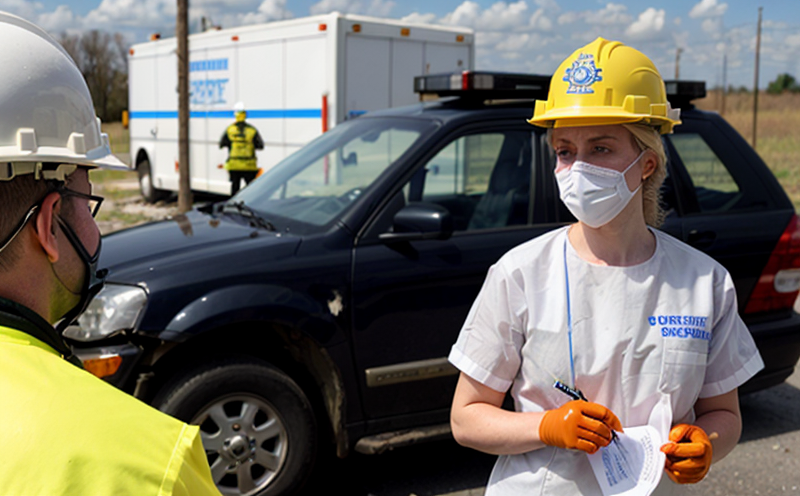ISO 11650 Uranium and Plutonium Measurement in Accident Samples
The ISO 11650 standard provides a comprehensive framework for the measurement of uranium (U) and plutonium (Pu) in accident samples, ensuring accurate and reliable quantification under stringent environmental and safety conditions. This service is critical for emergency response teams dealing with radiation accidents or nuclear incidents. The ability to rapidly assess contamination levels allows for prompt and effective mitigation strategies.
Accidents involving radioactive materials can have severe implications for human health and the environment. By adhering to ISO 11650, laboratories ensure that their methods meet international best practices, thereby providing stakeholders with confidence in the accuracy of results. This standard applies to various types of accident samples including soil, water, air, and biota.
The process involves several key steps: sample collection, preparation, analysis using appropriate instrumentation, and finally reporting findings according to ISO 11650 guidelines. Sample preparation is crucial; it ensures that the sample remains intact during transport and analysis while minimizing potential contamination risks. Once collected and prepared, samples undergo rigorous chemical separation followed by instrumental detection.
Instrumentation plays a pivotal role in this service offering precise quantitative data essential for decision-making processes regarding public safety measures or remediation efforts. Commonly used instruments include high-resolution gamma spectrometers, mass spectrometers equipped with multi-collector ICP-MS (Inductively Coupled Plasma Mass Spectroscopy), and alpha spectrometry systems.
Reporting must comply with ISO 11650 requirements which specify the format, content, and presentation of results. Compliance officers can use these reports to monitor trends over time or compare results between different locations affected by similar incidents. Quality managers rely on such data when evaluating internal procedures aimed at preventing future accidents.
This service is vital not only for emergency responders but also for R&D engineers developing new technologies focused on radiation detection and mitigation. It supports procurement activities by ensuring that suppliers meet necessary quality standards before being considered for contracts related to nuclear safety equipment or services.
Understanding the nuances of ISO 11650 helps stakeholders appreciate why this service is indispensable in today’s world where nuclear technology continues to evolve rapidly. By leveraging this standard, laboratories contribute significantly towards safeguarding public health and minimizing environmental impact following any radiation accident.
Applied Standards
| Standard | Description |
|---|---|
| ISO 11650:2019 | Measurement of uranium and plutonium in accident samples. |
| ASTM E1787-14 | Determination of radionuclides by alpha spectrometry. |
| National Nuclear Data Center (NNDC) | Data compilation for nuclear reactions, including those involving U and Pu isotopes. |
Scope and Methodology
The scope of ISO 11650 Uranium and Plutonium Measurement in Accident Samples encompasses the entire lifecycle of sample handling from initial collection through final analysis. It covers both manual and automated techniques applicable to various matrices such as liquid, solid, gas, or mixed phase materials.
Methodology includes detailed instructions for preparing samples according to recognized protocols that reduce variability introduced during preprocessing stages. This ensures consistent results regardless of the analyst performing them. Pre-treatment steps may involve dissolution methods designed to release target elements into solution form suitable for subsequent analytical procedures.
Analytical techniques specified by ISO 11650 include neutron activation analysis (NAA), liquid scintillation spectroscopy, and inductively coupled plasma mass spectrometry (ICP-MS). Each technique offers unique advantages depending on the specific requirements of a given project. For instance, NAA provides high detection limits for trace elements while ICP-MS allows simultaneous determination of multiple isotopes with high precision.
Post-analysis procedures ensure that all generated data conforms to specified tolerances and reporting formats stipulated by ISO 11650. This includes quality control measures implemented at every stage, from sample preparation right up until final documentation. Rigorous validation exercises conducted periodically verify the reliability of analytical methods employed against certified reference materials.
Reporting follows strict guidelines outlined in the standard document itself. Results are presented clearly and concisely with appropriate metadata included such as matrix type, concentration levels detected, and associated uncertainties. This information enables decision-makers to interpret results accurately and take informed actions promptly.
Eurolab Advantages
EuroLab offers unparalleled expertise in ISO 11650 Uranium and Plutonium Measurement in Accident Samples, leveraging advanced instrumentation and experienced personnel. Our state-of-the-art facilities equipped with cutting-edge technology allow us to deliver precise measurements even under challenging conditions.
Our team of highly qualified scientists brings extensive experience working on similar projects across diverse sectors including healthcare, energy production, and environmental protection. We stay updated on latest developments within the field ensuring that our services remain at the forefront of innovation.
EuroLab prides itself on providing comprehensive support throughout each project lifecycle—from initial consultation through final report delivery. Our dedicated professionals are committed to exceeding expectations by offering personalized attention tailored specifically for your unique needs. Whether you need assistance with sample preparation, method development, or simply require interpretation of complex data sets, we have the expertise required.
We understand that time is often critical in emergency situations involving radioactive materials. That’s why EuroLab prioritizes efficiency without compromising quality. Our streamlined processes enable us to turn around results quickly while maintaining accuracy and completeness. This rapid turnaround ensures that decision-makers receive timely information necessary for effective response planning.
In addition, EuroLab adheres strictly to international standards ensuring consistency across all projects regardless of location or sample type. By doing so, we foster trust among clients knowing they can rely on consistent, high-quality results every time.





